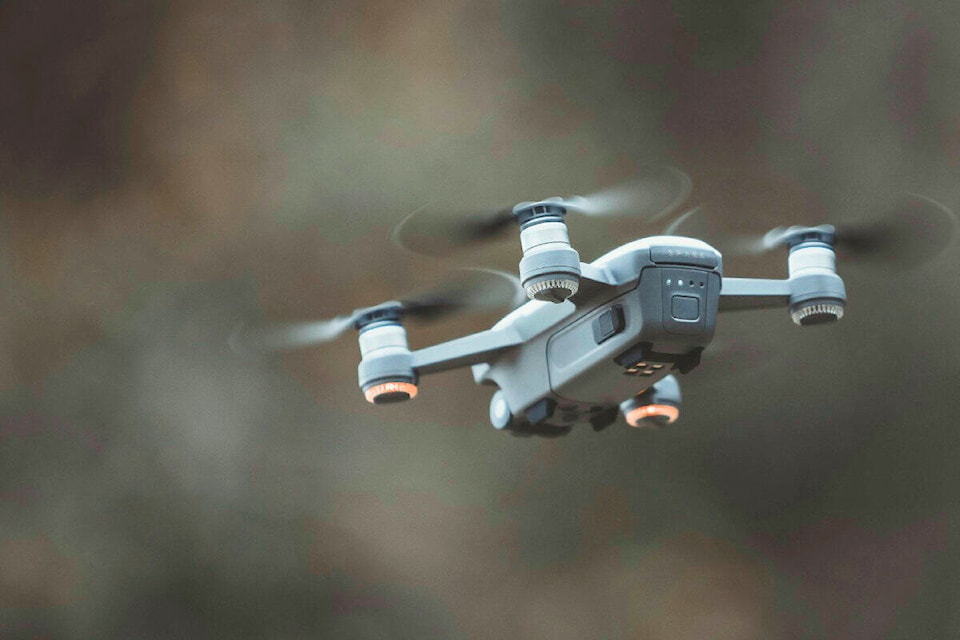by Rachael Lesosky
Local Journalism Initiative Reporter, Valley Voice
With wildfires increasingly affecting the availability of helicopters, the mosquito control program in the Lardeau Valley is getting creative.
“We got really interested in drones a few years ago,” said Dirk Lewis during an open house on May 6 at the Lardeau Valley Community Hall. Lewis is the head of Morrow Biosciences, the company contracted to manage the mosquito program.
Area D Director Aimee Watson and RDCK environmental co-ordinator Todd Johnston also attended, along with a handful of residents.
Brought in under referendum in the mid-90s, the mosquito control program relies on a combination of hand treatments and helicopter applications of Bacillus thuringiensis israelensis (Bti), a host-specific bacterial larvicide. Specific sites are sampled in the flooded lands of the Lardeau Valley and the north end of Kootenay Lake. When sites reach a certain number of larvae, Bti is spread over the area.
Hand treatments are the most precise, but helicopters can cover large swaths much faster – though they come with a $2,800/hour price tag.
And Lewis said the last five years have been brutal for trying to get helicopters.
“I’ve never had that in 25 years,” he said. “They’re usually always available and keen to do it.”
Morrow Biosciences bought their first drone in 2016. There are two sizes: a smaller one that can hold eight kilograms of Bti, and a larger one that can carry 50-to-60 kg.
Due to some provincial red tape, using drones for pesticide application is still about a year out. In the meantime, Lewis and his crew are learning how to use them for studying areas and mapping out application routes. GPS and sophisticated software means five drones could be operating at one time, co-ordinating themselves to pick up where the other left off. Though the economy of scale is not as large as helicopters, the potential is there.
Lewis is looking forward to when the province gives the go-ahead.
“For one, they’ll be fun,” he said with a laugh. “But two, I’ll have more autonomy over it. One of the challenges of helicopters is that they’re all off fighting fires.”
Even if helicopters are available, their high price tag means the applications have to be done all at once.
“If you apply Bti too early or too late it won’t work, because the larvae have very specific feeding times,” said Lewis. “But once we can use the drones, we can treat early, then hold off, then bring in the helicopters, then tidy up with the drone afterwards.”
Drones won’t soon be replacing helicopters, but as they increase in size and carrying capacity, it’s possible they could one day, Lewis said. But using drones and helicopters in tandem will be a step in a more efficient and sustainable direction.
Drones can also be used for other purposes, like spreading agricultural fertilizer and whitewashing greenhouses when it gets too hot in July.
“It diversifies our services, gives us something to do in July and August,” Lewis said.
As the program prepares for launching the drones, Watson said they’re also focusing on public education.
“We have to make sure people know what they are,” she said. “It can be scary and intimidating.”
One resident told Watson that he was glad he knew what the drone was — otherwise, he may have taken certain measures to deal with it.
Some treatment areas are on public land, but need to be accessed through private land.
“Some properties are, rightfully so, concerned about that,” said Watson. “There are some instances where we need to find happy mediums with the public to access treatment sites.”
With lots of cows in the area, the program hopes drones can be a less disruptive alternative to helicopters, for livestock, wildlife, and residents alike.
